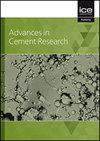通过加速养护和废料整合提高加气混凝土的性能
IF 1.3
4区 工程技术
Q3 CONSTRUCTION & BUILDING TECHNOLOGY
引用次数: 0
摘要
本文讨论了加气砌块的机械性能和耐久性能。在本研究中,在不使用铝粉的情况下,使用不同的胶凝材料和碱性溶液(AS)制备加气砌块。在进行了 P1 和 P2 两次混合试验后,选择了原材料的比例,并保持砌块的密度不变,即 800 公斤/立方米。每种混合料在六种固化机制下进行进一步测试,即普通水固化、湿度室固化(50°C 和 70% 相对湿度)6 小时和 10 小时、烘箱干燥固化(180°C 6 小时和 80°C 24 小时)以及加速固化(ACT)(65°C±5°C 10±2 小时),并命名为试验 "1"。在试验 "2 "中,采用了最佳的固化机制,并在两种混合比例中以不同比例用建筑和拆迁废物代替粉煤灰。此外,试验 "3 "还研究了最佳混合比例,即分别用 50%和 100%的玻璃粉代替粉煤灰和建筑和拆卸废料。实验结果表明,使用 50%的 CDW 和在 ACT 中进行热固化的加气砌块在 7 天硬化后显示出较高的机械性能和耐久性能。本文章由计算机程序翻译,如有差异,请以英文原文为准。
Enhancing the performance of aerated concrete through accelerated curing and waste material integration
This article discusses the mechanical and durability properties of aerated blocks. In present study, aerated blocks prepared by using different cementitious materials along with the alkaline solution (AS) in the absence of aluminium powder. The proportions of raw materials are chosen after performing two mix trials P1 and P2, keeping the density of blocks constant i.e., 800 kg/m3. Each mix is further tested under six curing mechanisms, viz, normal water curing, humidity chamber curing at (50°C and 70% relative humidity) for 6 hours and 10 hours, oven drying curing at 180°C for 6 hours and at 80℃ for 24 hours and using accelerated curing (ACT) at 65°C±5°C for 10±2 hours and named as trial “1”. In trial “2” the best curing mechanism is taken and construction and demolition waste are substituted at different proportions in place of flyash in both the mix proportions. Further, trial “3” is investigated on the best mix proportion by substituting glass powder at 50% and 100% with flyash and CDW, respectively. It is observed from experiments that aerated blocks manufactured with 50% CDW and heat curing done in the ACT showed high mechanical and durability properties after 7 days of hardening.
求助全文
通过发布文献求助,成功后即可免费获取论文全文。
去求助
来源期刊

Advances in Cement Research
工程技术-材料科学:综合
CiteScore
3.70
自引率
5.00%
发文量
56
审稿时长
3.2 months
期刊介绍:
Advances in Cement Research highlights the scientific ideas and innovations within the cutting-edge cement manufacture industry. It is a global journal with a scope encompassing cement manufacture and materials, properties and durability of cementitious materials and systems, hydration, interaction of cement with other materials, analysis and testing, special cements and applications.
 求助内容:
求助内容: 应助结果提醒方式:
应助结果提醒方式:


